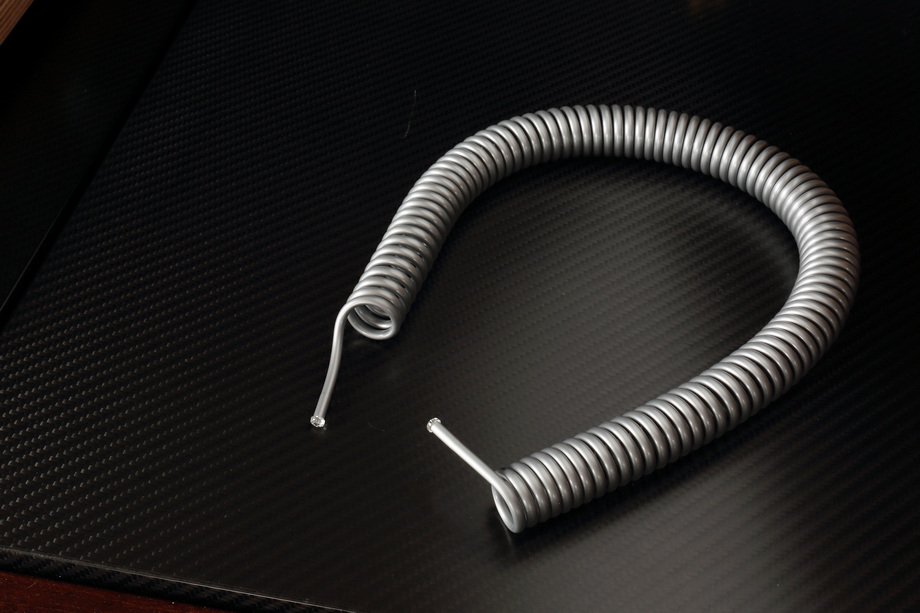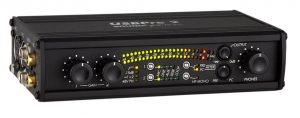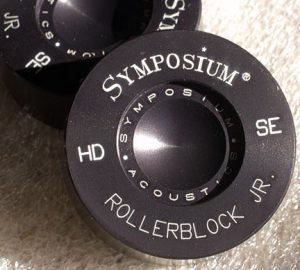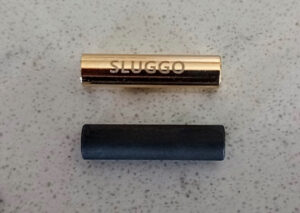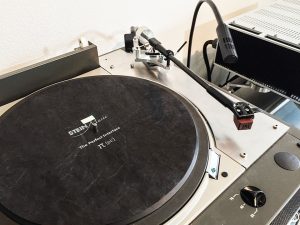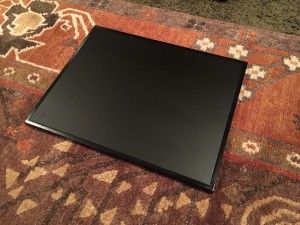Kryna Inc. was established on 21st May 1980 in the city of Machida-shi, which is part of Tokyo Metropolis. Its CEO is Mr. Ryoka Ina who employs only five people. The company offers both cables and vibration reducing products. We are testing an untypical product, the Helca 1 and Helca 2, RFI/EMI and vibration filters, placed on signal and power cables.
Kryna is a company specializing in two fields: audio signal transmission and vibration reduction. As we wrote in the Palette anti-vibration platform test, this is not another "me too" type manufacturer, following others and peering at what others are doing. It is a full-blooded audiophile manufacturer collaborating with Kinday University, where the theoretical foundations of its products are developed and where they are then measured and tested.
It is a small company which employs only five people. Nevertheless, its product range is quite broad, and its products are made to a high professional standard. The core of its product range are interconnects, feet and anti-vibration platforms, that is, products that are intuitively "in line" with the expectations and habits of people from the audio industry. This time, however, I would like to show you something completely different—not so obvious. Helca is a gender-neutral name known in more than thirty countries, meaning "intuition," "an assistant" or even "an impressive speaker." So, it all adds up.
Helca
To outsiders, a product called Helca may seem like an oddity, as here we get something that resembles a telephone cable (if you still remember landlines) in small stringed pouches. Instead of a straight section of cable, a landline phone featured a cable twisted into a spiral, so that it could be stretched quite a bit, after which it returned to its original state, taking up much less space and not getting tangled. We should add that headphones are equipped with cables of this type in the pro world.
OPERATION
Helca is not a cable, however. It is a product designed for vibration reduction and protection against RFI/EMI radiation, wrapped around a cable; its ends are attached using Velcro straps. There are spirals designed for cables of different diameters ϕ: Helca 1—up to 20 mm, and Helca 2—up to 12 mm. The lengths of protected cables in both cases range from 0.75 mm to 1 m. Slightly cheaper, shorter sections are also available, bearing the names H-Helca 1 and H-Helca 2, respectively, designed for cable lengths in the range of 0.3 to 0.5 m.
Sticky liquid, which Kryna calls the "Sticky solution," is placed inside the grey twisted pipe. It was originally developed for the D-Prop and C-Prop feet, where it is poured into the "cups" in which the spikes rest. Its purpose is to minimize vibrations and extinguish those transmitted by the spikes to and from the devices. The company owes its development to the research of Mr. Kiminobu Nishimura, a professor in the engineering department of Kindai University.
The material discussed is both sticky and resilient. As we read in the company materials, the solution is highly transparent, sticky "like rice cake" and highly elastic. Unlike water or oil, this physical property, which the company materials refer to as "solution elasticity," absorbs harmful vibrations and eliminates micro vibrations that particularly affect music reproduction. In the subsection "magnetic field cancellation", the manufacturer writes that particles move in it under the influence of magnetic field fluctuations. The mechanical properties of the solution make it possible to extinguish them (convert them into heat).
In the part devoted to vibration damping we can read that:
The sticky solution used in Helca is designed to dampen current and absorb vibration energy by spinning molecules in the solution under the influence of magnetic and electric field fluctuations. It is like an electrolyte in an electrolytic capacitor and has frequency characteristics in which absorption characteristics change depending on the frequency of the current flowing and the type of vibration. An example of how it works would be a microwave oven. (...) Helca has been tuned to handle all kinds of waves (both in digital and analog systems), electromagnetic fields and vibrations.
Kryna.jp, accessed: 5.05.2023
The Helca 1 and Helca 2 can be used regardless of cable installation location and type, and that is why they are "very effective when different cables cross at the back of the shelf and when we use cables without grounding." The method was invented by the company's founder, Mr. Ryukei Ina, and took him five years to implement. As he says:
Noise reduction not only creates clear sound, but also makes the location of the sound image clearer. Reverberation is enhanced and three-dimensional holography is created. This is an embodiment of Kryna's HGS (Holographic Sound) philosophy, and Helca is a product that expresses the goals of the brand and the direction in which it is heading. (Ibidem)
APPLICATION
In its brand images and press materials related to the Helca 1 and 2 filters, the manufacturer suggests a really broad range of applications, ranging from AC power cables, through interconnects, to switching power supply, LAN and USB cables. Both cables themselves and cable harnesses can be isolated—for example, power cables from signal cables, or analog cables from digital cables.
As Kryna is an engineering company, i.e., one that develops its products on the basis of scientific research and conducts listening tests only in the second phase, its website features a table with test results. It shows that Helca spirals also reduce the impact of magnetic field fluctuations associated with the lack of ground routing in an audio system. When the Helca filters are used, attenuation averages about 2 dB, but, as we read, "looking at dispersion which shows fluctuation, you can see that it can be reduced by up to 80 dB." In PC benchmark tests, on the other hand, Helca improved HDD signal transfer speeds by about 2-3%. It does not seem like much, but in audio everything matters, and we still do not fully understand how such small changes translate into clear sound improvements.
THE LISTENING SESSION
THE WAY WE LISTENED
Kryna's RFI/EMI filters, the Helca 1 and Helca 2 models (including H-Helca versions), were tested in the High Fidelity reference system. Instead of the Ayon Audio CD-35 HF Edition SACD player, a Well Tempered Lab Amadeus Jr. turntable (HERE) was installed with a Charisma Audio cartridge and an Aurorasound ViDA Mk II phono preamplifier, which were connected via a Luna Cables Blue interconnect with an Orange ground wire. The preamplifier's power supply was connected to a Harmonix X-DC350M2R Improved-Version cable.
The Helca 1 model was tested using Luna Cables interconnects, while the Helca 2—with the use of AC Harmonix interconnects. It was a multiple A/B/A and B/A/B comparison, with A and B known. Since it is quite time-consuming to put on and remove the Helca filters, this time I listened to whole pieces, three at a time in a "package," rather than short fragments.
Albums used in the test | a selection
The Art Ensemble of Chicago, The Spiritual, Freedom/ORG Music RGM-2121, "Record Store Day 2019", Limited Edition, 180 g RED WAX LP (1972/2019), HERE.
Frank Sinatra, Sinatra at the Sands, Reprise Records/Universal Music/Stereo Sound SSAR-065~066, 2 x 140 g LP (1966/2022), HERE .
Brendan Perry, Ark, Cooking Vinyl/Vinyl 180 VIN180LP040, 2 x 180 g (2011).
Sade, Stronger Than Pride, Epic/Sony Music/Audio Fidelity AFZLP 159, Numbered Edition № 0033, 180 g LP (1988/2014).
The Spiritual album by The Art Ensemble of Chicago always makes me consternated during the first several seconds of the recording. Confused, I listen to sounds incredibly close to live sound, but coming from different directions, not permanently connected to the listening axis, or even to its turn. You can hear it as if the phase has been swapped, either on the speakers' or the amplifier's side.
After a moment of accommodation, however, something "clicks" and I realize that everything is fine and this is my, and not the recording's problem. Accustomed to multi-track multi-mono recordings, I am not ready for real space—and this is what was achieved on this album first by the sound engineers, J.P Dupuy and P. Quef, and then by the remastering engineer Dave Garner. The version I am talking about, created for the Record Store Day 2019, was cut from the original "master" tape.
When I placed the Helca 2 spiral on the Luna Cables interconnects connecting the turntable and phono preamp, the impression I am talking about disappeared. I no longer had to look around me, trying to figure out when I could have swapped the "plus" with the "minus" in the speaker cables, because what settled before me was a deep and much more weighted down soundstage. It is amazing how much of a difference adding one inexpensive element made. The element in question was introduced into a high-end system featuring carefully selected components—but still.
When I repeated the same procedure with the Helca 1 on a cable plugged into the phono preamplifier power supply, I heard additional improvement. When I later listened to music with only the Kryna filter on the power cable, the effect was greater than when the Helca 2 was already in the system, but it was the interconnects that gained the most out of having the tested component in the system.
The changes introduced by the Japanese filter, as it should probably be called, resembled what I had heard before with filters from Acoustic Revive, Verictum and Thunder Melody. That would make sense, since they all serve to dampen vibrations and protect against high-frequency and electromagnetic radiation. The amazing effect I heard with The Art Ensemble of Chicago album is part of these changes.
Sound from the Helca 1 and Helca 2 in a system becomes more "present." These are actually small changes, little shifts, but they have a powerful effect, as if there was more "connective tissue" of something that is usually heard between "big" sounds, that is, those with high amplitude and energy. However, precisely because of this, the energy of the musical message increased, and phantom images established their place on the stage. It was all no longer "blown away" but established. I am exaggerating a bit, it is clear, but these are the emotions the changes stirred in me.
The concierge announcing Frank Sinatra during his performance at The Sands Hotel was also clearer in his 3D image and more energetic. Helca takes something off the sound, something that leads to exaggerating the attack. With the Helca 1 and 2, both small percussion instruments on The Spiritual, as well as cymbals from Sinatra's album were less literal in overdriving that can be heard in these recordings from time to time.
What is interesting, it also seems that there is less bass. The double bass at the beginning of Sinatra at the Sands, bass from Sade's album Stronger Than Pride, or the electronic and really low bass from Brendan Perry's piece The Devil and the Deep Blue Sea on the Ark album, all of the instruments seemed less dominant in the system with the Helca filters. However, it is the case that Kryna's products bring calmness and relaxation to sound, making songs seemingly quieter than when the filters are not used. However, when you turn up the volume knob by 1 dB, the previous (subjective) volume level is restored, but it is much more dynamic and energetic, with stronger, better balanced bass.
Although the sound is louder then, it is also more pleasant and less offensive than without the Helca filter. I am exaggerating again, yet it is not meant to deceive you, but to describe my impressions. Without the Japanese filters in the system, I did not miss anything. After placing them on the cables, there was a slight improvement, as all the elements I have mentioned were added to the sound, but it did not change its character in the same way as changing the cables. And yet, despite this, the cumulative effect they had on me, the listener, was much bigger than what would have resulted from a rational calculation.
Conclusion
The beauty of the Helca 1 and Helca 2 relies on us being able to add them to an already well set-up system and achieve an improvement. There is no need to change anything in it, it is not a revolution, and the sound will be better: freer, with better defined 3D images, more energetic. It seems to me that also the timbre is better balanced with the filters.
At a time when the number of electromagnetic interference emitters and HF noise generators is growing, such assistance is invaluable. Let us hide all power cables in them (including those from switching power supplies!) and thus help interconnects, and we will gain a lot for relatively little money. I can tell you that even placing the H-Helca 1 on the cable connecting the power supply and phono preamplifier had a positive effect. So, let us try, look for "weak links" in the system and enjoy the music. Because that, after all, is the point.
Prices (at the time of the test):
- Helca 1 – €205
- Helca 2 – €150
Kryna Inc.
4-2-38, Kanamori Higashi, Machida-shi
Tokyo 194-0015 | JAPAN
MADE IN JAPAN
The tested product was supplied by: MUSON PROJECT [email protected]
text WOJCIECH PACUŁA
translation Ewa Muszczynko
images High Fidelity




